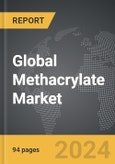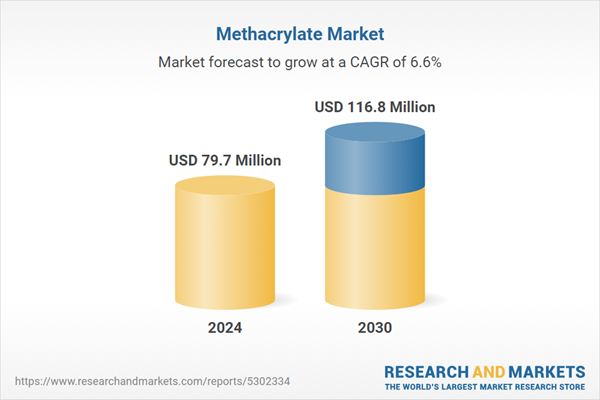The global market for Methacrylate was valued at US$79.7 Million in 2024 and is projected to reach US$116.8 Million by 2030, growing at a CAGR of 6.6% over the analysis period 2024-2030. This comprehensive report provides an in-depth analysis of market trends, drivers, and forecasts, helping you make informed business decisions. The report includes the most recent global tariff developments and how they impact the Methacrylate market.
Segments: Segment (Methacrylate).
Geographic Regions/Countries: World; United States; Canada; Japan; China; Europe (France; Germany; Italy; United Kingdom; Spain; Russia; and Rest of Europe); Asia-Pacific (Australia; India; South Korea; and Rest of Asia-Pacific); Latin America (Argentina; Brazil; Mexico; and Rest of Latin America); Middle East (Iran; Israel; Saudi Arabia; United Arab Emirates; and Rest of Middle East); and Africa.
The analysts continuously track trade developments worldwide, drawing insights from leading global economists and over 200 industry and policy institutions, including think tanks, trade organizations, and national economic advisory bodies. This intelligence is integrated into forecasting models to provide timely, data-driven analysis of emerging risks and opportunities.
Global Methacrylate Market - Key Trends and Drivers Summarized
What Is Methacrylate and Why Is It So Important in Modern Applications?
Methacrylate is a key chemical compound that forms the foundation of numerous industrial and commercial products, renowned for its versatility, durability, and performance. Chemically, methacrylate refers to esters of methacrylic acid, with methyl methacrylate (MMA) being the most commonly used form. Methacrylate compounds are highly valued for their ability to polymerize, making them essential in producing plastics, resins, coatings, adhesives, and many other materials. One of the most widely recognized products made from methacrylate is acrylic glass, often referred to as PMMA (polymethyl methacrylate), known for its exceptional optical clarity, strength, and resistance to weathering. These qualities make methacrylate-based materials ideal for a wide range of applications, from the automotive and construction industries to medical devices and consumer goods. Methacrylate’s importance in modern manufacturing cannot be overstated - it serves as a cornerstone in industries that require durable, lightweight, and high-performance materials, offering an optimal balance between cost and functionality. As industries innovate and grow, methacrylate continues to be indispensable due to its adaptability and the range of properties it can impart to finished products.How Does Methacrylate Technology Shape Industry Innovation?
The unique properties of methacrylate have made it central to technological advancements across several industries. One of the most significant areas where methacrylate has had an impact is in the production of lightweight, shatter-resistant materials. For example, in the automotive and aerospace industries, methacrylate polymers are used to manufacture parts that are both strong and lightweight, contributing to fuel efficiency and overall vehicle performance. The same attributes that make methacrylate valuable in these sectors also make it a preferred material for manufacturing outdoor signage, protective barriers, and optical lenses, all of which require high levels of transparency and resistance to UV degradation. Moreover, methacrylate's polymerization process is highly controllable, allowing manufacturers to tailor its properties for specific needs - whether it's increasing flexibility, hardness, or chemical resistance. This adaptability has led to its widespread use in 3D printing technologies, where precision, material strength, and clarity are critical for creating detailed prototypes and parts. Additionally, methacrylate resins play a key role in the coatings industry, particularly in applications where fast curing times and durable finishes are essential, such as in automotive paints and industrial coatings. The combination of fast processing, long-lasting durability, and resistance to environmental factors like moisture and heat makes methacrylate an unparalleled choice for a variety of cutting-edge industrial processes.Why Is Methacrylate in High Demand Across Various Industries?
Methacrylate’s broad utility has made it a material of choice across a variety of industries, each benefiting from its specific attributes. In the medical field, for example, methacrylate compounds are used in the production of bone cement for orthopedic surgeries and in dental applications, where their biocompatibility, strength, and transparency are vital. The compound’s versatility allows it to be used in medical devices, such as intraocular lenses, prosthetics, and contact lenses, due to its ability to form clear, durable, and flexible materials. Similarly, in the construction industry, methacrylate is widely used in the production of coatings, adhesives, and sealants. Its chemical stability and resistance to extreme temperatures, chemicals, and weathering make it ideal for use in exterior building materials, road markings, and flooring systems. Methacrylate-based materials also offer high resistance to abrasion and impact, which is why they are often found in public infrastructure projects like bridges and highways. In addition, the consumer goods sector relies heavily on methacrylate for products like acrylic sheets, which are used for furniture, displays, and even household items due to their aesthetic appeal and durability. The electronics industry, too, benefits from methacrylate in the production of flat screens, light panels, and other components requiring clarity and conductivity. As technology evolves and industries seek materials that offer both performance and cost-efficiency, methacrylate remains a go-to choice due to its broad applicability and reliable performance in even the most demanding conditions.What Are the Key Drivers of Growth in the Methacrylate Market?
The growth in the methacrylate market is driven by several factors, most notably the increasing demand for lightweight, durable, and high-performance materials in key industries like automotive, construction, electronics, and healthcare. In the automotive and aerospace sectors, manufacturers are continually seeking to reduce the weight of vehicles to improve fuel efficiency and meet stringent environmental regulations, which has led to a surge in demand for methacrylate-based polymers. These materials offer the perfect balance of strength, lightness, and durability, making them essential for producing components such as windows, interior trims, and lighting systems. The construction industry's demand for methacrylate products has also been a significant driver, especially in the growing need for durable and weather-resistant coatings, sealants, and adhesives. This demand is further amplified by the ongoing trend toward green building practices and sustainability, where methacrylate’s long lifespan and recyclability are seen as key advantages. Additionally, the rise of digitalization and advanced manufacturing techniques, such as 3D printing, has bolstered the methacrylate market. Methacrylate resins, with their rapid curing times and precision, are increasingly being used in additive manufacturing processes to produce intricate designs and prototypes quickly and cost-effectively. Furthermore, the healthcare industry’s reliance on methacrylate for biocompatible medical devices and prosthetics continues to expand as the global population ages, driving increased demand for medical innovations. The shift towards minimally invasive surgical procedures and the growth of the dental industry, both of which use methacrylate extensively, further fuel this demand. Lastly, the market is propelled by technological advancements in methacrylate production processes, which have led to the development of more environmentally friendly and efficient manufacturing techniques, reducing costs and expanding the range of applications. These growth drivers ensure that methacrylate will continue to see strong demand across multiple sectors well into the future.Report Scope
The report analyzes the Methacrylate market, presented in terms of units. The analysis covers the key segments and geographic regions outlined below.Segments: Segment (Methacrylate).
Geographic Regions/Countries: World; United States; Canada; Japan; China; Europe (France; Germany; Italy; United Kingdom; Spain; Russia; and Rest of Europe); Asia-Pacific (Australia; India; South Korea; and Rest of Asia-Pacific); Latin America (Argentina; Brazil; Mexico; and Rest of Latin America); Middle East (Iran; Israel; Saudi Arabia; United Arab Emirates; and Rest of Middle East); and Africa.
Regional Analysis
Gain insights into the U.S. market, valued at $20.9 Million in 2024, and China, forecasted to grow at an impressive 9.5% CAGR to reach $26.6 Million by 2030. Discover growth trends in other key regions, including Japan, Canada, Germany, and the Asia-Pacific.Why You Should Buy This Report:
- Detailed Market Analysis: Access a thorough analysis of the Global Methacrylate Market, covering all major geographic regions and market segments.
- Competitive Insights: Get an overview of the competitive landscape, including the market presence of major players across different geographies.
- Future Trends and Drivers: Understand the key trends and drivers shaping the future of the Global Methacrylate Market.
- Actionable Insights: Benefit from actionable insights that can help you identify new revenue opportunities and make strategic business decisions.
Key Questions Answered:
- How is the Global Methacrylate Market expected to evolve by 2030?
- What are the main drivers and restraints affecting the market?
- Which market segments will grow the most over the forecast period?
- How will market shares for different regions and segments change by 2030?
- Who are the leading players in the market, and what are their prospects?
Report Features:
- Comprehensive Market Data: Independent analysis of annual sales and market forecasts in US$ Million from 2024 to 2030.
- In-Depth Regional Analysis: Detailed insights into key markets, including the U.S., China, Japan, Canada, Europe, Asia-Pacific, Latin America, Middle East, and Africa.
- Company Profiles: Coverage of players such as Asahi Kasei Corporation, Chi Mei Corporation, Evonik Industries, Kuraray Group, LG MMA Corp. and more.
- Complimentary Updates: Receive free report updates for one year to keep you informed of the latest market developments.
Some of the 43 companies featured in this Methacrylate market report include:
- Asahi Kasei Corporation
- Chi Mei Corporation
- Evonik Industries
- Kuraray Group
- LG MMA Corp.
- Makevale Group
- Mitsubishi Rayon Group
- Polycasa N.V.
- Shanghai Jing-Qi Polymer Science Co.
- Sumitomo Chemical Company Ltd.
- The Dow Chemical Company
Tariff Impact Analysis: Key Insights for 2025
Global tariff negotiations across 180+ countries are reshaping supply chains, costs, and competitiveness. This report reflects the latest developments as of April 2025 and incorporates forward-looking insights into the market outlook.The analysts continuously track trade developments worldwide, drawing insights from leading global economists and over 200 industry and policy institutions, including think tanks, trade organizations, and national economic advisory bodies. This intelligence is integrated into forecasting models to provide timely, data-driven analysis of emerging risks and opportunities.
What’s Included in This Edition:
- Tariff-adjusted market forecasts by region and segment
- Analysis of cost and supply chain implications by sourcing and trade exposure
- Strategic insights into geographic shifts
Buyers receive a free July 2025 update with:
- Finalized tariff impacts and new trade agreement effects
- Updated projections reflecting global sourcing and cost shifts
- Expanded country-specific coverage across the industry
Table of Contents
I. METHODOLOGYII. EXECUTIVE SUMMARY2. FOCUS ON SELECT PLAYERSIII. MARKET ANALYSISIV. COMPETITION
1. MARKET OVERVIEW
3. MARKET TRENDS & DRIVERS
4. GLOBAL MARKET PERSPECTIVE
UNITED STATES
CANADA
JAPAN
CHINA
EUROPE
FRANCE
GERMANY
ITALY
UNITED KINGDOM
SPAIN
RUSSIA
REST OF EUROPE
ASIA-PACIFIC
AUSTRALIA
INDIA
SOUTH KOREA
REST OF ASIA-PACIFIC
LATIN AMERICA
ARGENTINA
BRAZIL
MEXICO
REST OF LATIN AMERICA
MIDDLE EAST
IRAN
ISRAEL
SAUDI ARABIA
UNITED ARAB EMIRATES
REST OF MIDDLE EAST
AFRICA
Companies Mentioned (Partial List)
A selection of companies mentioned in this report includes, but is not limited to:
- Asahi Kasei Corporation
- Chi Mei Corporation
- Evonik Industries
- Kuraray Group
- LG MMA Corp.
- Makevale Group
- Mitsubishi Rayon Group
- Polycasa N.V.
- Shanghai Jing-Qi Polymer Science Co.
- Sumitomo Chemical Company Ltd.
- The Dow Chemical Company
Table Information
| Report Attribute | Details |
|---|---|
| No. of Pages | 94 |
| Published | April 2025 |
| Forecast Period | 2024 - 2030 |
| Estimated Market Value ( USD | $ 79.7 Million |
| Forecasted Market Value ( USD | $ 116.8 Million |
| Compound Annual Growth Rate | 6.6% |
| Regions Covered | Global |









